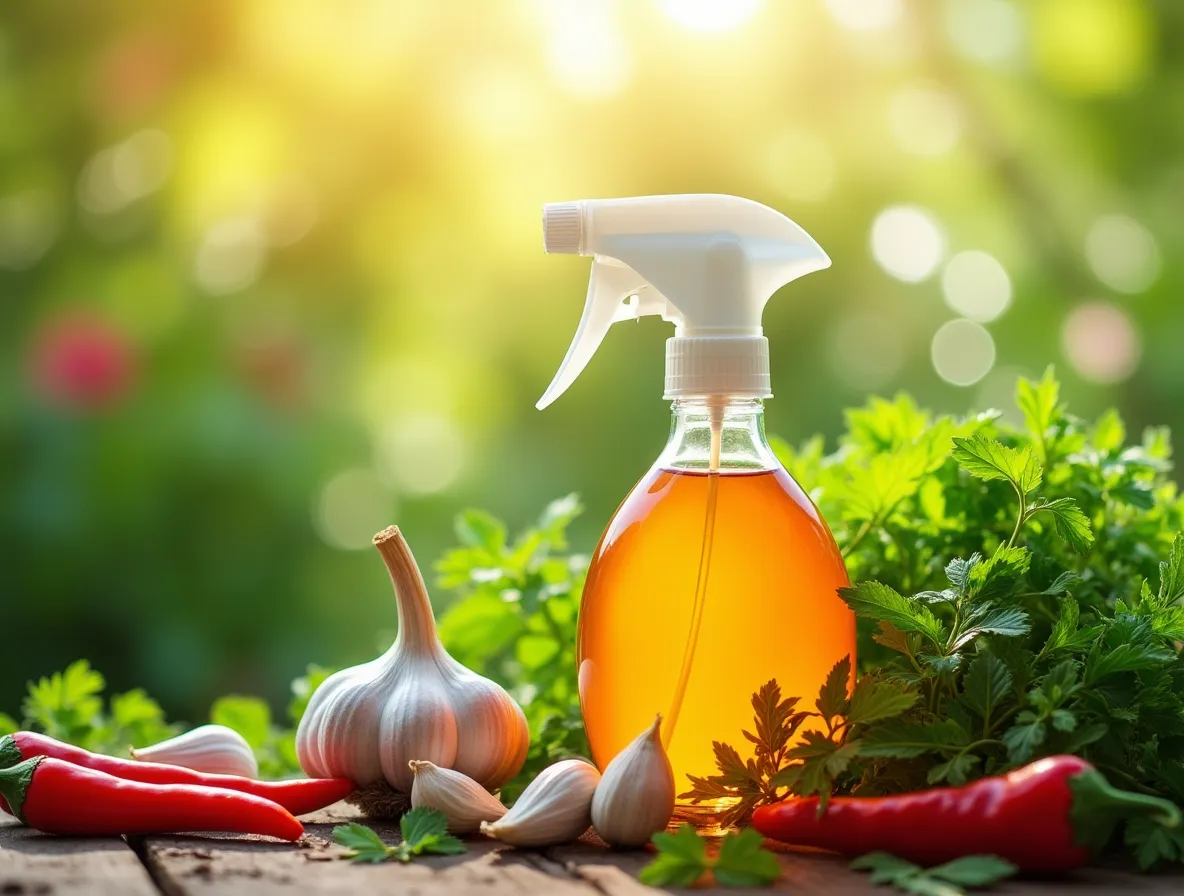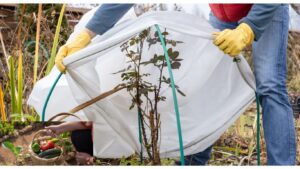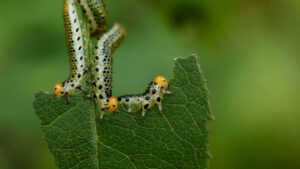Introduction to Organic Bug Sprays
Garden pests can be a real headache, especially when you’re trying to grow organic vegetables and flowers. Instead of reaching for chemical sprays that can harm the environment and your plants, why not try organic bug sprays? These natural, DIY solutions are not only safer but also effective in keeping pests at bay.
Organic bug sprays are made from simple, everyday ingredients like garlic, chili, soap, and even coffee. They’re easy to make at home, cost-effective, and free from harmful chemicals. Plus, they help protect beneficial insects like bees and ladybugs, which are essential for a healthy garden ecosystem.
In this guide, we’ll share several DIY organic bug spray recipes that you can whip up in no time. We’ll explain how each spray works, which pests they target, and how to use them safely. Whether you’re dealing with aphids, caterpillars, slugs, or other common garden pests, these organic bug sprays can help you keep your garden thriving without compromising on your organic principles.
Let’s get started and discover how you can tackle pest problems naturally with organic bug sprays!
On This Page
Chili Spray: A Natural Repellent
If you’re looking for a simple and effective way to keep pests like aphids, caterpillars, and snails away, chili spray is a great place to start. This natural repellent is easy to make and uses ingredients you probably already have in your kitchen.
How to Make Chili Spray
To make your own chili spray, you’ll need:
- 1 part dried chili flakes (or 2 parts fresh chopped chili peppers)
- 2 parts water
- Blend the chili flakes or fresh chilies with water until well mixed.
- Strain the mixture to remove any solid pieces.
- Pour the liquid into a spray bottle.
How It Works
The capsaicin in chili peppers is what makes this spray effective. It irritates pests, making your plants less appealing to them. When sprayed on leaves, it creates a barrier that deters insects from feeding or laying eggs.
Tips for Using Chili Spray
- Test First: Before spraying your entire garden, test the spray on a small section of a plant to make sure it doesn’t cause any damage.
- Reapply After Rain: Chili spray can wash off in heavy rain, so you may need to reapply it after a downpour.
- Protect Yourself: Wear gloves and avoid touching your eyes or face while handling chili spray. The capsaicin can cause irritation.
When to Use It
Chili spray works best as a preventive measure or for mild pest infestations. Use it on plants like tomatoes, peppers, and leafy greens that are prone to aphids or caterpillars.
With just a few simple steps, you can create a powerful organic bug spray that keeps pests at bay without harming your plants or the environment. Next, let’s explore another natural solution: garlic spray.
Garlic Spray: A Broad-Spectrum Insecticide
If you’re dealing with a variety of garden pests, garlic spray is a versatile and effective solution. Garlic’s strong smell and natural compounds make it a powerful repellent for insects like aphids, whiteflies, and even some beetles. Plus, it’s easy to make at home with just a few ingredients.
How to Make Garlic Spray
To create your own garlic spray, you’ll need:
- 2-3 cloves of fresh garlic
- 2 tablespoons of cooking oil
- 2 cups of water
- A dash of natural soap (optional, for better adhesion)
- Crush or finely chop the garlic cloves.
- Soak the garlic in the cooking oil overnight. This helps extract the active compounds.
- The next day, mix the garlic and oil with 2 cups of water.
- Blend the mixture well, then strain it to remove any solid pieces.
- Add a dash of natural soap (if using) to help the spray stick to plant leaves.
- Pour the liquid into a spray bottle.
How It Works
Garlic contains sulfur compounds that repel pests and can even disrupt their feeding and breeding habits. When sprayed on plants, it creates an unpleasant environment for insects, discouraging them from sticking around.
Tips for Using Garlic Spray
- Dilute Before Use: Garlic spray is strong, so always dilute it with water before applying it to your plants. A good ratio is 1 part garlic concentrate to 6 parts water.
- Avoid Overuse: While garlic spray is effective, using it too often can harm beneficial insects. Use it sparingly and only when pests are a problem.
- Reapply as Needed: Like chili spray, garlic spray can wash off in rain, so reapply after heavy rainfall.
When to Use It
Garlic spray is particularly useful for plants that are prone to aphids, whiteflies, or cabbage moths. It’s also a good option for protecting roses, tomatoes, and leafy greens.
Garlic spray is a fantastic addition to your organic bug spray toolkit. It’s simple, effective, and safe for your garden. Next, let’s look at another natural pest control method: clay spray.
Clay Spray: Smothering Sap-Sucking Pests
For pests like aphids, mites, and other sap-sucking insects, clay spray can be a game-changer. This natural solution works by coating the pests and their eggs, effectively smothering them without harming your plants or beneficial insects.
How to Make Clay Spray
To make clay spray, you’ll need:
- Natural clay (available at craft stores or garden centers)
- Water
- Mix a small amount of clay with water until you achieve a thin, sprayable consistency. The mixture should be smooth and free of lumps.
- Pour the mixture into a spray bottle.
How It Works
Clay spray forms a fine layer over the leaves and stems of your plants. When pests come into contact with it, the clay sticks to their bodies, blocking their ability to breathe and feed. It’s especially effective against soft-bodied insects like aphids and spider mites.
Tips for Using Clay Spray
- Test First: Before spraying your entire plant, test the clay spray on a small section to ensure it doesn’t clog the leaves or cause damage.
- Apply Evenly: Make sure to coat the undersides of leaves where pests often hide.
- Reapply as Needed: Clay spray can wash off in rain, so reapply after heavy rainfall or as pests reappear.
When to Use It
Clay spray is ideal for plants that are heavily infested with sap-sucking pests like aphids, whiteflies, or spider mites. It’s particularly useful for delicate plants like roses, herbs, and leafy greens.
Clay spray is a gentle yet effective way to control pests without resorting to harsh chemicals. It’s a great addition to your organic bug spray arsenal. Next, let’s explore another natural solution: glue spray.
Glue Spray: A Safe Solution for Caterpillars and Slugs
If you’re battling caterpillars, slugs, or other soft-bodied pests, glue spray is a simple and effective solution. Made from basic kitchen ingredients, this spray works by suffocating pests while being completely safe for your plants and the environment.
How to Make Glue Spray
To create your own glue spray, you’ll need:
- 1 cup of flour
- 1 cup of boiling water
- 3 cups of cold water
- Mix the flour with the boiling water to create a thick paste.
- Gradually add the cold water, stirring until the mixture becomes smooth and thin enough to spray.
- Pour the mixture into a spray bottle.
How It Works
The sticky consistency of the glue spray coats the bodies of pests like caterpillars and slugs, making it difficult for them to move or breathe. It also swells up inside their stomachs if ingested, further deterring them from feeding on your plants.
Tips for Using Glue Spray
- Target Pests Directly: Spray the mixture directly onto the pests or the areas where they are most active.
- Reapply as Needed: The spray can wash off in rain, so reapply after heavy rainfall or as pests return.
- Clean Sprayer After Use: Flour can clog spray nozzles, so make sure to clean your sprayer thoroughly after each use.
When to Use It
Glue spray is particularly effective for plants that are prone to caterpillar damage, such as cabbage, broccoli, and kale. It’s also useful for protecting seedlings from slugs and snails.
Glue spray is a safe, non-toxic way to control pests without harming your plants or the environment. Next, let’s dive into another natural pest control method: dead bug spray.
Dead Bug Spray: Nature’s Own Pesticide
While it might sound a bit unusual, dead bug spray is a natural and effective way to control pests in your garden. This method uses the bodies of the pests themselves to create a spray that deters other insects from invading your plants.
How to Make Dead Bug Spray
To make dead bug spray, you’ll need:
- A handful of the pests you’re trying to control (e.g., aphids, caterpillars, or beetles)
- Water
- Collect the pests from your garden.
- Blend the pests with three parts water until the mixture is smooth.
- Let the mixture sit overnight to steep.
- Strain the liquid to remove any solid pieces.
- Dilute the concentrate with 30 parts water.
- Pour the mixture into a spray bottle.
How It Works
The idea behind dead bug spray is that the scent and compounds from the dead pests act as a warning to other insects, signaling that the area is dangerous. This can help deter pests from returning to your plants.
Tips for Using Dead Bug Spray
- Target Specific Pests: This spray works best when you use the same type of pest you’re trying to control. For example, if you’re dealing with aphids, use aphids to make the spray.
- Use Sparingly: While effective, this spray should be used as a last resort or for severe infestations, as it can be a bit labor-intensive to prepare.
- Reapply as Needed: Like other organic sprays, dead bug spray may need to be reapplied after rain or as pests return.
When to Use It
Dead bug spray is particularly useful for controlling persistent infestations of pests like aphids, whiteflies, or caterpillars. It’s a good option for plants like roses, tomatoes, and brassicas (e.g., cabbage, broccoli).
While it may not be the most glamorous solution, dead bug spray is a natural and effective way to protect your garden from pests. Next, let’s explore another organic option: soap spray.
Soap Spray: A Versatile Pest Control Solution
Soap spray is one of the most popular and versatile organic bug sprays for gardeners. It’s effective against a wide range of pests, including aphids, whiteflies, and spider mites, while being gentle on plants and the environment.
How to Make Soap Spray
To create your own soap spray, you’ll need:
- 1 tablespoon of natural liquid soap (avoid detergents or heavily scented soaps)
- 1 liter of water
- Mix the soap with the water in a spray bottle.
- Shake well to ensure the soap is evenly distributed.
How It Works
Soap spray works by breaking down the protective outer layer of soft-bodied insects, causing them to dehydrate and die. It’s particularly effective against pests like aphids, which have a waxy coating that the soap can penetrate.
Tips for Using Soap Spray
- Test First: Before spraying your entire plant, test the solution on a small section to ensure it doesn’t cause any damage. Some plants, like ferns or succulents, can be sensitive to soap.
- Spray Directly: Target the pests directly, focusing on the undersides of leaves where they often hide.
- Avoid Sunlight: Apply soap spray in the early morning or late afternoon to prevent the sun from burning the leaves.
- Reapply as Needed: Soap spray can wash off in rain, so reapply after heavy rainfall or as pests return.
When to Use It
Soap spray is ideal for plants that are prone to aphids, whiteflies, or spider mites. It’s especially useful for vegetables like tomatoes, peppers, and leafy greens, as well as ornamental plants like roses.
Soap spray is a simple, effective, and eco-friendly way to control pests in your garden. Next, let’s explore another powerful natural solution: pyrethrum spray.
Pyrethrum Spray: A Stronger Natural Insecticide
For gardeners dealing with more stubborn pests, pyrethrum spray is a powerful natural solution. Made from the flowers of the pyrethrum plant, this spray is effective against a wide range of insects, including aphids, beetles, and caterpillars. However, it should be used with caution to avoid harming beneficial insects like bees.
How to Make Pyrethrum Spray
To make your own pyrethrum spray, you’ll need:
- A handful of fresh or dried pyrethrum flowers (or a store-bought pyrethrum concentrate)
- Water
- If using fresh flowers, steep a handful of pyrethrum flowers in hot water for several hours to create a strong tea.
- Strain the liquid to remove any solid pieces.
- Dilute the concentrate with water according to the instructions (if using store-bought concentrate).
- Pour the mixture into a spray bottle.
How It Works
Pyrethrum contains natural compounds called pyrethrins, which attack the nervous systems of insects on contact. It’s fast-acting and effective, but it breaks down quickly in sunlight, making it less harmful to the environment than synthetic pesticides.
Tips for Using Pyrethrum Spray
- Use in the Evening: To protect bees and other beneficial insects, apply pyrethrum spray in the early evening when they are less active.
- Target Pests Directly: Spray directly on the pests or the areas where they are most active.
- Avoid Overuse: Pyrethrum is a broad-spectrum insecticide, meaning it can harm both pests and beneficial insects. Use it sparingly and only when necessary.
- Reapply as Needed: Pyrethrum breaks down quickly, so you may need to reapply it every few days for severe infestations.
When to Use It
Pyrethrum spray is best for controlling stubborn infestations of pests like aphids, beetles, and caterpillars. It’s particularly useful for vegetables like tomatoes, peppers, and brassicas, as well as fruit trees.
While pyrethrum spray is a stronger option, it’s important to use it responsibly to protect your garden’s ecosystem. Next, let’s explore a unique and surprising solution: coffee spray
Coffee Spray: A Natural Deterrent for Slugs and Snails
If slugs and snails are wreaking havoc in your garden, coffee spray might be the solution you’ve been looking for. This natural spray uses caffeine to deter these slimy pests, and it’s easy to make with leftover coffee grounds or brewed coffee.
How to Make Coffee Spray
To create your own coffee spray, you’ll need:
- 1 part strong brewed coffee (or espresso)
- 10 parts water
- Mix the coffee with water in a spray bottle.
- Shake well to ensure the mixture is evenly combined.
How It Works
Caffeine is toxic to slugs and snails, and even small amounts can deter them from feeding on your plants. When sprayed on the soil or leaves, the coffee mixture creates an unpleasant environment for these pests, encouraging them to move elsewhere.
Tips for Using Coffee Spray
- Spray the Soil: Focus on spraying the soil around your plants, as this is where slugs and snails are most active.
- Reapply After Rain: Coffee spray can wash away in rain, so reapply after heavy rainfall or as pests return.
- Avoid Overuse: While coffee is safe for plants in small amounts, too much can affect soil pH. Use it sparingly and only when needed.
- Use Leftover Grounds: If you don’t want to make a spray, you can also sprinkle used coffee grounds around the base of plants to deter slugs and snails.
When to Use It
Coffee spray is particularly effective for plants that are prone to slug and snail damage, such as lettuce, hostas, and strawberries. It’s also a great option for seedlings, which are often targeted by these pests.
Coffee spray is a simple, eco-friendly way to protect your garden from slugs and snails. Next, let’s explore another natural pest control method: pepper dust.
Pepper Dust: A Simple and Effective Deterrent
For a quick and easy way to keep pests at bay, pepper dust is a great option. Made from ground pepper, this natural deterrent works by irritating pests and discouraging them from feeding on your plants. It’s especially effective against soft-bodied insects like aphids and caterpillars.
How to Use Pepper Dust
To use pepper dust in your garden, you’ll need:
- Ground black pepper or cayenne pepper
- Sprinkle the pepper dust directly onto the leaves of plants where pests are active.
- Focus on areas where pests are most likely to feed, such as the undersides of leaves or around the base of plants.
How It Works
The capsaicin in pepper irritates pests, making your plants less appealing to them. It’s a simple yet effective way to create a barrier that deters insects without harming your plants.
Tips for Using Pepper Dust
- Reapply After Rain: Pepper dust can wash away in rain, so reapply after heavy rainfall or as pests return.
- Use Gloves: When handling pepper dust, wear gloves to avoid irritation to your skin or eyes.
- Combine with Other Methods: For best results, use pepper dust alongside other organic pest control methods, such as companion planting or mulch.
When to Use It
Pepper dust is ideal for plants that are prone to aphids, caterpillars, or other soft-bodied pests. It’s particularly useful for vegetables like tomatoes, peppers, and leafy greens, as well as ornamental plants like roses.
Pepper dust is a simple, cost-effective way to protect your garden from pests. Next, let’s wrap up with some general tips for using organic bug sprays effectively.
General Tips for Using Organic Bug Sprays Effectively
Using organic bug sprays is a great way to protect your garden from pests while keeping it safe for beneficial insects, wildlife, and your family. To get the most out of these natural solutions, here are some general tips to keep in mind:
1. Test Before You Spray
- Always test any new spray on a small section of your plant before applying it to the entire garden. Some plants may be sensitive to certain ingredients, and testing helps avoid damage.
2. Apply at the Right Time
- Spray in the early morning or late afternoon to avoid direct sunlight, which can cause the spray to dry too quickly or burn the leaves.
- Avoid spraying during the heat of the day or when bees and other pollinators are most active.
3. Target Pests Directly
- Focus on spraying the areas where pests are most active, such as the undersides of leaves or the base of plants. This ensures the spray is most effective.
4. Reapply as Needed
- Organic sprays can wash off in rain or break down over time. Reapply after heavy rainfall or as pests return.
5. Rotate Your Sprays
- Pests can build up resistance to certain sprays over time. Rotate between different types of organic sprays (e.g., chili, garlic, soap) to keep pests guessing and maintain effectiveness.
6. Encourage Beneficial Insects
- While organic sprays are safer than chemicals, they can still affect beneficial insects if overused. Encourage predators like ladybugs, lacewings, and birds to help control pests naturally.
7. Keep Your Garden Healthy
- Healthy plants are less likely to attract pests. Focus on building healthy soil, proper watering, and companion planting to create a garden ecosystem that naturally resists pests.
8. Store Sprays Properly
- Most homemade sprays should be used immediately or stored in a cool, dark place for a short time. Label your sprays with the date and ingredients to avoid confusion.
9. Be Patient
- Organic pest control often takes time to show results. Be consistent with your applications, and don’t expect overnight miracles. Over time, you’ll see a reduction in pest populations.
Conclusion: Embracing Organic Gardening Practices
Gardening is more than just growing plants—it’s about creating a healthy, balanced ecosystem where plants, insects, and wildlife can thrive together. By using organic bug sprays and other natural pest control methods, you’re not only protecting your garden but also contributing to a healthier environment.
The Benefits of Going Organic
- Safe for Your Family and Pets: Organic sprays are free from harmful chemicals, making them safe to use around children and animals.
- Eco-Friendly: By avoiding synthetic pesticides, you’re protecting beneficial insects, birds, and soil health.
- Cost-Effective: Most organic sprays are made from inexpensive, everyday ingredients, saving you money in the long run.
- Sustainable: Organic gardening practices, like composting and mulching, help build healthy soil and reduce waste.
A Final Word of Encouragement
Switching to organic pest control might feel overwhelming at first, but it’s a rewarding journey. Start small by trying one or two DIY sprays, like chili spray or soap spray, and see how they work in your garden. Over time, you’ll learn what works best for your plants and pests, and you’ll develop your own natural gardening toolkit.
Remember, a healthy garden is a resilient garden. By focusing on soil health, biodiversity, and natural pest control, you’ll create a space that’s not only beautiful but also productive and sustainable.
Thank you for joining us on this journey into organic pest control! With these organic bug spray recipes and tips, you’re well-equipped to tackle garden pests the natural way. Happy gardening, and may your garden flourish without the need for harmful chemicals!









